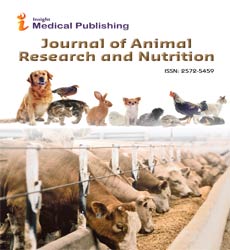Abstract
Effect of Vitamin C and D on Growth and Immunology of Rohu La ( beo Rohita) Fingerlings in District Lahore
The present study was scheduled for 90 days to determine the effect of vitamin C and D on growth and immunology of Rohu (Labeo rohita) fingerlings at Fisheries Research and Training Institute, Manawan district Lahore, Punjab, Pakistan in 12 different ponds (July 1 to September 30, 2019) with 3 different treatments and a control one. Four levels of treatment were used vitamin C (0.00, 0.23 g, 0.48 g, and 0.69 g) and vitamin D (0.00, 0.26 g, 0.43 g, and0.68 g) in triplicate groups. Supplementary feed that was composed of sunflower meal, maize gluten meal and rice polish (1:1:1) was applied to fish @ 2% of fish body weight twice a day. Artificial diets were formulated which contained 32.20% crude protein. All the water quality assessments/parameters fluctuated in values during the course of an experiment like temperature â??, dissolved oxygen, pH, carbon dioxide, alkalinity, total hardness and planktonic biomass. All these parameters were tested on every 10th day so each pond was sampled thrice in a month. Final weight was (wt) 265.4 ± 4.15 g (control), 272.5 ± 2.42 g (T1), 280.5 ± 2.80 g (T2) and 291.0 ± 5.75 g (T3) respectively. SGRs were 0.6 ± 0.01% (control), 0.6 ± 0.01% (T1), 0.8 ± 0.01% (T2) and 0.5 ± 0.03% (T3) respectively. Weight gain was 18.6 ± 0.75 g (control), 20.0 ± 0.47 g (T1), 24.8 ± 2.25 g (T2) and 23.4 ± 1.68 g (T3) respectively. Survival rate (%) was 56.6 ± 2.51% (control), 60.3 ± 3.51% (T1), 85.3 ±2.51% (T2) and 72.3 ± 1.52% (T3) respectively. Average daily weight gain was (ADG) 0.2 ± 0.01 (control), 0.2 ± 0.01 (T1), 0.2 ± 0.01 (T2) and 0.2 ± 0.01 (T3) respectively which showed better results than other treatment groups. The vitamin C (AAs) and vitamin D was resolved in blood erythrocyte (1.5 ± 0.06 (T1), 1.5 ± 0.08 (T2), 2.3 ± 0.06 (T3) and 1.8 ± 0.12 (T4) respectively, hemoglobin 4.6 ± 0.30 (T1), 5.9 ± 0.73 (T2), 7.8 ± 0.25 (T3) and 7.1 ± 0.05 (T4) respectively). Body flesh enhanced the growth and immune system of fish. In control group (without vitamin C and D diet) hemoglobin levels decreased which might have decreased the oxygen carrying capacity in fish. Increased bacterial infection was perceived in the group which was fed on supplemented diet without vitamin C and D. Supplementary diet T2 indicated significantly (p<0.05) higher growth than the other treatments and control one. In Pakistan, supplementary diets of vitamin C and D were affected on the immunological parameters and growth assessment of fish Rohu (Labeo rohita).
Author(s): Aamira Urooj, Muhammad Ashraf, Aasma Nourin, Masroor Elahi Babar, M Tariq Pervaiz, and Tanveer
Abstract | Full-Text | PDF
Share this

Google scholar citation report
Citations : 764
Journal of Animal Research and Nutrition received 764 citations as per google scholar report
Abstracted/Indexed in
- Google Scholar
- China National Knowledge Infrastructure (CNKI)
- WorldCat
- International Committee of Medical Journal Editors (ICMJE)
- Secret Search Engine Labs
Open Access Journals
- Aquaculture & Veterinary Science
- Chemistry & Chemical Sciences
- Clinical Sciences
- Engineering
- General Science
- Genetics & Molecular Biology
- Health Care & Nursing
- Immunology & Microbiology
- Materials Science
- Mathematics & Physics
- Medical Sciences
- Neurology & Psychiatry
- Oncology & Cancer Science
- Pharmaceutical Sciences

